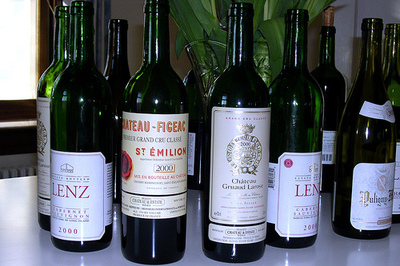As many of you know, last weekend I had the unique chance to blind taste several wines from
The Lenz Winery against great (and much more expensive) wines from
Burgundy and Bordeaux at an event held for Lenz wine club members.
Lenz is well known for using blind tasting such as this one to advance
its standing in the overall wine market. In a 1989 tasting against
French heavyweights like La Grande Dame, Chateau Petrus, J. Drouhin,
Montrachet Marquis de Laguiche, and Veuve Clicquot tasters were unable
to single out the Lenz wines as inferior in quality.
Saturday’s tasting wasn’t nearly as ambitious. Chateau Petrus is
insanely expensive and buying it for 25 people would have pushed the $50
per person event fee to “$400 or $500” according to winery owner Peter
Carroll. He seemed open to holding such an even, however, if people were interested.
The average price of the Lenz wines tasted was $20 while the
French bottles averaged $90. But, this tasting wasn’t just about
differences in price. As winemaker Eric Fry put it “This is a beauty
contest. Whatever wine you like best is the winner.”
The first flight, dedicated to crisper-style chardonnay, pitted Lenz
Winery 2003 White Label Chardonnay ($12) against 2003 Jean Louis Chevy,
Puligny-Montrachet ($35). Tasted blind, I chose the Lenz as my favorite
because of its nearly flawless balance. By comparison, the Jean Louis
Chevy seemed tight, lean and flat.
Flight number two featured Lenz Winery 2001 Silver Label Chardonnay
($15) and 2001 Domain Leflaive Clavoillons, Puligny-Montrachet ($80).
Again, I preferred the Lenz wine, by a narrow margin, which again
seemed much more balanced while the Burgundy was a little raw in the
oak department and lacking fruit.
It is worth noting, however that both chardonnay flights were served a
bit too cold. Over-chilled Chardonnay is a pet peeve of mine.
Our next flight featured two cabernet sauvignon-dominated bottlings,
Lenz Winery 2000 Cabernet Sauvignon ($30) and 2000 Gruaud-Larose, St.
Julien ($115). The Lenz was complex, with intense berries, toasty-sweet
spices and was almost meaty, with ripe tannins. Very approachable, I
thought it was drinking much better than the Gruaud-Larose, which was a
bit restrained and high in tannins. Five to ten years from now, when
it’s peaking, I expect that I’d prefer it to the Lenz, however.
The last flight of the afternoon put Lenz 2000 Estate Selection Merlot
($23) up against 2000 Figeac, St. Emilion ($105) and 2000 Le Bon
Pasteur, Pomerol ($110) in a supposed “Merlot Flight.” Only 30-percent
Merlot (with 35-percent Cabernet Franc and 35-percent Cabernet
Sauvignon) the Figeac seemed out of place, while the Le Bon Pasteur
seemed a bit “off” to me and it may have been slightly corked. It was
complex, smoky but extremely tannic and obviously not peaking. Again,
the Lenz wine won me over as the most ready to drink today.
The room was a little dark and the flights were rather rushed, but what
did we learn?
Never assume that a $100 wine is going to taste better
than a $15 bottle — especially when the $100 bottle is a still-young
Bordeaux. With substantial tannins, it really wasn’t fair to compare
them to the Long Island wines, which are ready now.
We also learned that while Merlot still rules Long Island, our
Chardonnay is a real bargain — especially the $12 White Label from
Lenz.
As Fry put it, “The definition of a good wine is that you like it,”
which means that, for me Lenz Winery makes good wine.

